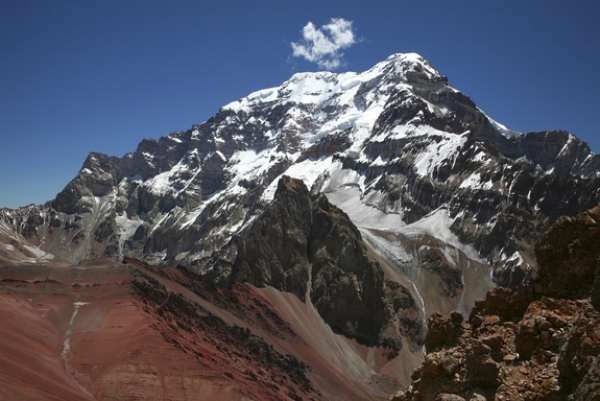Aconcagua: Highest Mountain in South America

Part of the Andes mountain range, Aconcagua is the second highest of the Seven Summits, behind only Mount Everest in Asia. At 22,837 feet (6,961 meters), not only is it the highest mountain in South America, it is the tallest peak in all of the Americas as well as the Southern and Western Hemispheres.
It is not known where the name Aconcagua came from, but one theory is that it derived from Aconca Hue, an Arauca phrase that translates as "comes from the other side" — meaning the other side of the Aconcagua River. Another possibility is that it is derived from Ackon Cahuak, Quechuan words meaning "stone sentinel." Other options for the origin of the name are the Quechuan phrase Ancho Cahuac or "white sentinel," or the Aymara Janq'u Q'awa, meaning "white ravine."
While some think Aconcagua is a volcano, it is not. The mountain was formed when the Nazca Plate and the South American Plate collided during the relatively recent Andean orogeny, defined as a period of mountain formation through upward displacement of the earth's crust.
Where is Aconcagua?Aconcagua is located in Argentina, in the province of Mendoza, and lies 70 miles (112 kilometers) northwest of the provincial capital, Mendoza, and 9.3 miles (15 km) from the border with Chile.
To the north and east is Valle de las Vacas, and to the west and south is the Valle de los Horcones Inferior. The mountain is part of the Aconcagua Provincial Park, a protected natural area in the Andes that was established in 1983.
Climate at AconcaguaThe mountain is dotted with glaciers, with the largest one being the Ventisquero Horcones Inferior, which is 6.2 miles (10 km) long and near the Confluencia camp on the south face at about 11,811 feet (3,600 m). Other large glacier systems include Ventisquero de las Vacas Sur, Glaciar Este/Ventisquero Relinchos and the north-eastern or Polish Glacier, which is a popular ascent route.
During the summer, the temperature at night above 16,400 feet (5,000 m) is about minus 4 F (minus 20 C), and the typical temperature at the summit is minus 22 F (minus 30 C). The cold, snowy and unpredictable conditions discourage most from trying to summit in winter.
Life on AconcaguaThere is a fair amount of wildlife and vegetation on Aconcagua compared to some of the other Seven Summits. There are a number of low bushes, such as yellow firewood, yareta and goat horn, and there are open pastures made up of grasses such as huecú and ichu.
Many varieties of birds inhabit the area, including the condor, the purple eagle and a species of snipe called agachona. Spotted sandpipers and torrrentes, a type of duck, thrive in some of the areas with water. Mountain rats and the red fox are among the most common land animals.
Climbing AconcaguaAbout 60 percent of climbers who attempt the mountain succeed in summiting. Because it is not a highly technical climb, many mistakenly believe that it will be an easy ascent. More than 135 climbers have died on Aconcagua — primarily because of complications of altitude sickness, but also from falls, heart attacks, hypothermia and other causes due to severe weather — and about three climbers die each year on Aconcagua.
The most common route up Aconcagua is the Normal Route along the Northwest Ridge. In total it takes about 21 days from Mendoza, including hiking to the base of the mountain, establishing camps, doing acclimatization climbs, summiting and descending.
Milestones in Aconcagua history1897: American-born mountaineer Edward FitzGerald leads the first known ascent of Aconcagua. Swiss climber Mathias Zurbriggen reaches the summit alone on Jan. 14, followed a few days later by Nicholas Lanti and Stuart Vines, who were also members of the expedition team.
1940: French climber Adrienne Bance is the first woman to summit as part of an expedition from of the Andinist Club of Mendoza.
1953: Argentines E. Huerta, H. Vasalla and F. Godoy make the first winter ascent from Sept. 11 to 15.
1984: Titoune Meunier is the first woman to climb the South Face. She reaches the summit, along with her former husband John Bouchard, using the French 1954/Messner route.
1985: A well-preserved skeleton is discovered at 17,060 feet (5,200 m) on the southwest ridge of Cerro Pyramidal, an Aconcagua sub-peak, providing evidence that the pre-Colombian Incas had climbed Aconcagua.
2007: Scott Lewis, at 87, is the oldest person to summit when he makes his ascent on Nov. 26.
2008: On Dec. 16, Matthew Moniz, 10, of Boulder, Colo., is the youngest to reach the summit.
2013: Tyler Armstrong, a 9-year-old boy from Yorba Linda, Calif., plans to attempt to be the youngest to summit when he sets out in December 2013.

Facebook comments